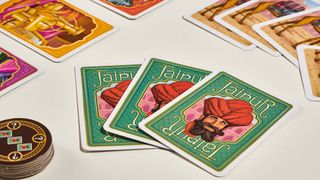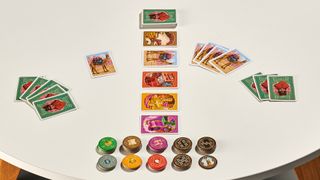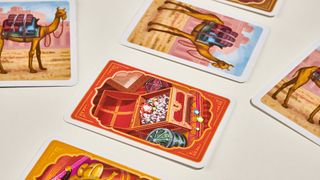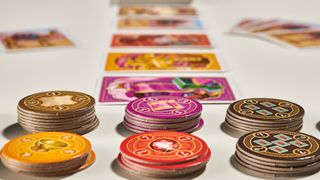Jaipur is a board game that captures the essence of its theme with breathtaking simplification. You play as merchants, trying to corner the market in a variety of goods. In a real market, flooding it with produce lowers the price. So in Jaipur, the first goods of a given type you sell are worth more points than the later ones. Simple.
Except, in another hallmark of a great game, the strategy is anything but simple. You’ll be juggling various stock lines against limited storage space. Being named after the city of Jaipur in north India, there are camel trains to manage and colorful art to admire.
There are good reasons why this has remained an established classic since its release in 2009, and tops our list of the best two-player board games and is a staple of our picks of the best cheap board games. (Please note that the current version has a box that looks a little different to our photo above, but the game remains the same.)

Jaipur board game: Price and who it's for
This small box contains cards and a bunch of cardboard counters, so it won’t break the bank to buy. Prices are around £14/$20 for a copy of the latest edition. If you want an even smaller financial and physical footprint, there’s a great app version available for mobile phones.
One constraint is that this is for two players only. And since it’s a competitive game with a slice of luck, you better pick someone who won’t mind losing – and you won’t mind losing to – as an opponent. As such, while younger kids might get the rules, this may not be the best game for them. The 12+ age suggested on the box feels about right. For adults, it's just a matter of whether someone is too sore a loser to just shuffle the cards and go again or not!
With just a few narrow pages of rules to learn, it’s well suited for beginners or casual players but there’s easily enough strategy and replayability here to appeal to more hardcore board game fans too. Especially when you consider the play time of around half an hour in total.

Jaipur board game: How it plays
Jaipur is all about competing priorities and good timing. On your turn, you can either pick up cards (which represent the goods you’ll sell) from a face-up selection in the middle of the table that’s shared between both players, or you can sell cards from your hand to exchange them for points. That’s it. One or the other, then your opponent goes, and so on. You’d never imagine what a wealth of decisions that simple setup could hide.
All that strategy is forged with two simple tools. First, you get a secret, random bonus for selling three or more goods of the same kind at once. So it pays to be patient and stockpile more cards of the same type to sell at once, if you can. Second, however, you can’t have more than seven goods in your hand at once. So you’re going to have to make hard choices about what you collect. Mercifully, camel cards don’t count against your hand limit, so you can build them up separately and keep them for useful shenanigans in the future, which we’ll explain in a moment.
All the types of goods are worth different amounts, from valuable diamonds to cheap leather, and more expensive goods are rarer. If you take a card from the market in the middle then you’re also taking a risk: that when its replacement gets drawn could be a high-value card for your opponent to grab. But the alternative is to sell, and it’s best to sell sets, but how can you collect a set without taking cards?
In the end, something has to give and you’ll need to sell. Again, timing is everything because the earlier you sell, the more you get for your goods. Sometimes it’s best to cash in a single card early on just to grab the points, sometimes not. It all depends on what your opponent is selling and collecting and it pays to watch them like a hawk. Although the random draw off the top of the deck can feel a bit cruel if it hands your opponent some great cards, Jaipur is very much a skill-based game.

To help you navigate this mercantile maze, it’s possible to take multiple cards without revealing any new ones from the deck. To do this, you have to take at least two from the market and replace them with cards from your hand, or those useful camel cards you’ve been stashing.
You can’t buy or sell camels, only use them for this swap, but they’re easy to get. If you take one from the market, you actually get to take all the camels currently there, giving you a big pile of cards to make swaps with later. But beware, because this also means your opponent will get an extra-rich selection of new cards to choose from. There's also a bonus at the end for whoever has the most camels left in front of them.
Learning the right time to take, sell and swap is key to doing well. It can, however, lead to cagey passages of play where players are selling single cards, or keep swapping to stop revealing a new card for their opponent, which can frustrate. But this is a) a minor issue when a game only takes about 10 minutes, and b) not the way everyone will choose to play anyway. The rules say you’re supposed to play best of three but if you’re really pushed for time a one-off is still lots of fun.
In such a short game, though, it does have a bit of setup overhead. Sorting the points tokens into order of descending value and ensuring the deck is well-shuffled is a little bit time-consuming, though with repeated play you can get a fairly quick routine going, with each of you handling different duties. It’d be nice just to get the game out and get playing without any preparation, though, let alone re-preparing it for each round.
However you play, as two players competing head to head, it’s full of interaction and excitement. Flipping the next stock you know your opponent is collecting off the top of the deck is a real gotcha moment. So is finding out the extra diamond you’ve been waiting for has been in your foe’s hand since the beginning of the game. Each game feels a bit like a fencing match as you gain and lose ground. But you never quite know how well you’re doing until the final points tally, thanks to those secret bonus chips.

Jaipur board game: Verdict
Jaipur is a modern classic that offers you a lot of possibilities from only a few rules, and as such it has wide appeal. The main stalling point is that it’s two-player only, not something you can whip out to please a dinner party or a family. But if that's what you need right now, it's nearly perfect.
Some board gamers like to have a lot of crunch to their games, either in terms of strategic depth or simulation. Although there’s a lot of skill to playing Jaipur well and it does feel like a trading game, it’s a bit straightforward for either of the more hardcore camps. But just about everyone else will have a great time.
Jaipur board game: Also consider
If you’re after a two-player classic that’s even faster and lighter than Jaipur, take a look at Lost Cities. Here, players race to build chains of cards in numeric order.
A related, but more demanding game is Schotten-Totten. This sees the two players trying to put together poker-style hands to win a majority of nine flags.
There are a couple of multiplayer games that fit a similar bill to Jaipur, too: Splendor and Century: Spice Road. These are both light games that are easy to understand, but take a bit longer to play – they're more about building up your buying power over time than short term trade-offs. Splendor is our pick of the two, and not just because the trading is done with lovely custom poker chips (but it doesn't hurt).



